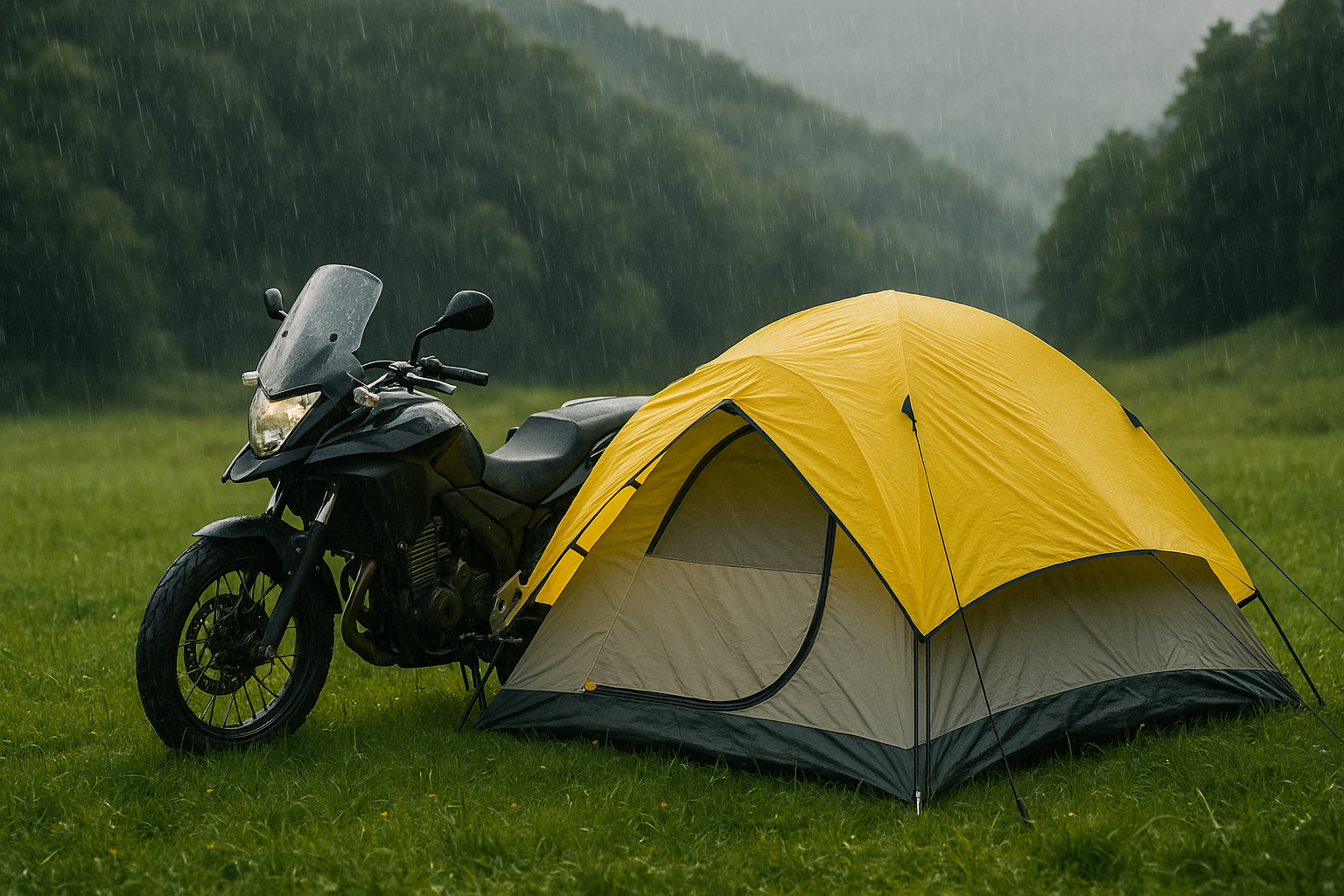You’ve spent all day on the road. Rain pelting your visor, wind pushing your bars, cold creeping into your gloves. You finally pull over, find a campsite, and set up your so-called “weatherproof” tent—only to wake up at 3 a.m. soaked to your damn spine.
If that sounds familiar, you’re not alone. Thousands of riders have made the same mistake: dropping $150–$200 on a tent that looks decent on paper, only to discover it folds under real-world conditions. Cheap seals. Garbage zippers. “Water-resistant” fabric that surrenders in five minutes of steady rain.
This post is your hard-earned shortcut. We’re not listing every camping tent under the sun—we’re zeroing in on a handful that have survived real storms, real road trips, and real disappointment. No marketing fluff. Just tents that work when the sky opens up.
What Real Riders Say After Getting Soaked
“It was rated ‘waterproof.’ It wasn’t. My sleeping bag felt like a sponge. Never again.”
“Looked great at REI. Pitched easy. Then the seam leaked right over my face.”
“Did a 3-day loop through the Smokies. It rained every night. The only dry place I had was my saddlebag.”
You’re not buying a tent for Instagram. You’re buying it for survival, rest, and sanity when you’re out in the elements with nothing but your gear and your grit. The difference between a soggy night and a dry camp often comes down to the details—seam taping, hydrostatic head ratings, vestibule design, and smart ventilation.
Key Features That Actually Keep You Dry
Before we dive into the best tents, here’s what separates a rain-proof tent from the ones that fail:
- Hydrostatic Head Rating of 1200mm+
That’s the water pressure the fabric can resist. Under 1000mm? Forget it.
Over 1500mm? Solid.
Over 2000mm? You’re armored. - Taped or Welded Seams
The stitching is where 90% of leaks start. If it’s not taped, it leaks. - Two-Layer Design (Rainfly + Inner Mesh Tent)
Keeps you dry and ventilated. Avoid “all-in-one” popup tents in rain. - Vestibule or Awning
You need a dry zone for your boots and wet gear. Trust us. - Low Profile & Wind-Resistant Frame
If it looks like a parachute, it’ll act like one in a storm.
These Motorcycle Tents Actually Survive Rain
We’ve picked these based on three things:
- Proven waterproof performance (not just marketing)
- Real packability for motorcycle panniers or tail bags
- Value that justifies the price—not regrets it
1. Lone Rider MotoTent V2 – For Riders Who Camp Like Commandos
- Hydrostatic Rating: 10,000mm rainfly (!)
- Weight: ~12 lbs
- Packed Size: 24” x 9” x 9”
- Amazon Link: Check Price
Yes, it’s pricey. But it’s made specifically for motorcycles, with a built-in garage that keeps your bike and your gear dry. It uses ultra-durable materials, stormproof zippers, and a design shaped to resist wind.
Why It’s Worth It:
- You get a true two-person sleeping area plus room to work on your bike
- 4-season durability
- Riders report surviving nights of sideways rain in Patagonia and Iceland
Best For:
Long-distance ADV riders, rainy climates, cross-continent trips
2. Naturehike Cloud-Up 2 Upgrade (with 20D Fly) – Ultralight & Waterproof Under $200
- Hydrostatic Rating: 4000mm fly / 3000mm floor
- Weight: 3.75 lbs
- Packed Size: 17.7” x 5.9”
- Amazon Link: Check Price
This tent punches way above its price point. Double-layer. Fully seam-sealed. Sets up in 5 minutes. It’s compact enough for panniers and weighs less than a gallon of gas.
Why It’s Not a Waste:
- Budget-friendly but doesn’t cut corners on waterproofing
- Withstands multi-day rain if guy lines are staked properly
- Easy to pitch solo
Best For:
Budget-conscious solo riders, ultralight packers, beginners
3. Big Agnes Copper Spur HV UL2 – Premium Performance in a Compact Package
- Hydrostatic Rating: 1200mm fly (sounds low, but it’s legit—high-quality silicone-treated)
- Weight: 3.2 lbs
- Packed Size: 19.5” x 6”
- Amazon Link: Check Price
Big Agnes is a trusted name in backpacking for a reason. This tent has survived Pacific Northwest monsoons, Appalachian downpours, and Rocky Mountain hailstorms.
Why It Performs:
- DAC Featherlite poles resist wind flex
- Double vestibules for gear
- High-quality materials + smart ventilation = dry nights
Best For:
Serious campers who want ultralight gear with zero compromise
4. ALPS Mountaineering Lynx 1 – Old-School Ruggedness That Still Beats the Rain
- Hydrostatic Rating: 2000mm+
- Weight: 4.2 lbs
- Packed Size: 17” x 6”
- Amazon Link: Check Price
This tent has been a budget favorite for years. It’s a bit bulkier than ultralight tents, but riders who’ve taken it through mountain storms say it’s rock solid when pitched right.
Why It’s a Workhorse:
- Polyester rainfly with factory-sealed seams
- Bathtub floor construction
- Fast setup and decent ventilation
Best For:
Budget riders who don’t mind a few extra ounces for durability
5. MSR Hubba Hubba NX 2 (New 2025 Model) – Modernized for Storm Durability
- Hydrostatic Rating: 1200mm fly + Xtreme Shield waterproof coating
- Weight: 3.5 lbs
- Packed Size: 19” x 6”
- Amazon Link: Check Price
MSR’s latest version of the Hubba Hubba has improved coating and seam tech, offering longer-lasting waterproofing without flaking.
Why It Made the Cut:
- Minimal pole segments = fast setup on uneven ground
- Field-tested by backpackers in the Alps, Andes, and Pacific Northwest
- Breathes well even in humid, wet environments
Best For:
Mid-range budget riders looking for high-end performance without going full MotoTent
Avoid These Mistakes When Buying a Motorcycle Tent for Rain
Even with a good tent, how you use it matters. Here’s what experienced riders never do:
- Assume “Water-Resistant” Means Waterproof
It doesn’t. Ever. - Skip the Footprint
A groundsheet or footprint adds protection from ground moisture and sharp rocks. Many tents don’t include one—buy or improvise. - Ignore Setup Angles
If your tent isn’t taut, water will pool and find a way in. Learn to pitch it right even in wind or uneven terrain. - Leave the Vent Flaps Closed
You’ll wake up in a sauna of condensation. Open them—even in rain—to keep airflow moving. - Forget the Extra Stakes and Guy Lines
Cheap tents barely include enough for sunny days. In wind + rain, use extra tie-outs or paracord.
Tips for Staying Dry Even if It Pours
- Always Pack a Small Microfiber Towel
For drying yourself and the inside of your tent if needed. - Pack Gear in Dry Bags Inside the Tent
The tent isn’t your only line of defense—treat your electronics and clothes like they will get wet and protect them individually. - Use the Vestibule Like a Mudroom
Keep boots, wet jackets, and water bottles outside the sleeping area. - Reproof When Needed
Even great tents lose waterproofing over time. Use Nikwax or Scotchgard to refresh the coating once a season.
Final Thoughts: Trust the Rain, Not the Marketing
You don’t need a $600 tent. But you do need a tent that’s built for real weather. If you’re motorcycle camping, especially in regions where rain is common—don’t fall for “lightweight” tents that can’t handle a drizzle.
Every tent on this list has been tested in real-world conditions by riders and backpackers who don’t have time for gear that folds under pressure.
So don’t blow $200 on another Amazon gamble.
Quick Recap: Tents That Actually Survive Rain
| Tent | Price Range | Weight | Rain Rating | Why It Works |
|---|---|---|---|---|
| Lone Rider MotoTent V2 | $$$$ | 12 lbs | 10,000mm | Best for bike + gear + extreme weather |
| Naturehike Cloud-Up 2 | $$ | 3.75 lbs | 4000mm | Budget ultralight that holds strong |
| Big Agnes Copper Spur | $$$ | 3.2 lbs | 1200mm | Premium build, serious field cred |
| ALPS Mountaineering Lynx 1 | $ | 4.2 lbs | 2000mm | Rugged classic for budget riders |
| MSR Hubba Hubba NX | $$$ | 3.5 lbs | 1200mm | High-end weatherproof, fast pitch |
Ride smart. Pack light. Stay dry.
You deserve a tent that does its damn job—especially when the road’s been long and the weather’s turned wild.

